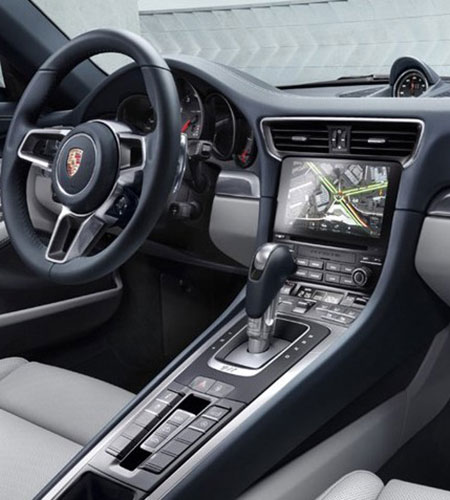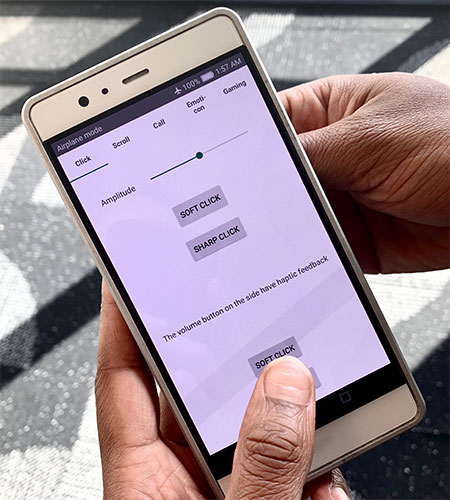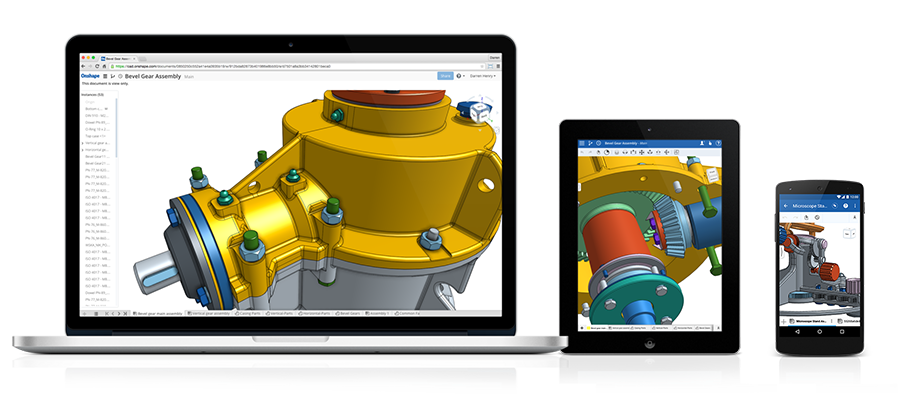Futuristic haptic technology is already here
Success at a glance:
- Onshape’s sharing feature allows Actronika to instantly share CAD models in real time.
- Built-in version control eliminates the risk of working on the wrong design version.
- Onshape’s CAD portability allows easier access for the company’s Linux-using software team to participate in design reviews.
In the bestselling book and subsequent movie “Ready Player One,” the futuristic world is obsessed with a virtual reality video game where millions of people interact as their fantasy avatars and wear “haptic suits” that enable them to feel the action. Although “Ready Player One” takes place in the year 2044, haptic technology is not science fiction, and its current applications go far beyond fighting dragons.
Derived from the Greek word “haptikos,” meaning “able to touch or grasp,” haptics is the science of touch. It examines how tactile sensations, perceptions, and actions together form a sensory loop allowing you to perceive and judge your environment—virtual or real. One haptic communication experience most people are familiar with is how a firm handshake is perceived differently in a social situation than a “dead fish” handshake.
“Essentially, we are enriching the relationship you might have with a machine by adding the sense of touch,” says Rafal Pijewski, co-founder and CTO of Actronika. “Sensations can happen at your fingertips or on any other part of your body. These vibrations can be transmitted on a screen, on a trackpad, on a seat, or a steering wheel. Anything you can touch.”
Actronika was launched in 2014, based on the research of Vincent Hayward, Professor of Tactile Perception and Technologies at Pierre and Marie Curie University (UPMC, Sorbonne Universités).
Touch-sensitive technology for cars, phones, and video games
Actronika’s three main focuses are the automotive, mobile, and gaming industries. Specific use cases include:
Automotive
- Enhancing a steering wheel with haptic alerts for security-based feedback.
- Equipping a car seat with musical bass-enhancing actuators.
- Decreasing visual attention-grabbing distractions by using only touch.
- Replacing mechanical buttons with customizable tactile clicks and buttons.
Mobile
- Replacing the phone speaker and providing sound through vibration of the screen.
- Exchanging more vibrant, impactful messages between friends and family.
- Creating a specific interactive library to perfectly match your app.
Gaming
- Feeling the hits and shots taken by your character.
- Wandering through the game environment and feeling different terrains.
- For “serious games,” interacting with your co-workers in virtual training simulations.

Actronika is a partner of Novares, a global plastic component supplier to OEMs and Tier- 1 companies in the automotive industry. The partners have recently teamed up to put haptic buttons, “smart surfaces” that feel like pressing mechanical buttons, into the entertainment screens for the Porsche Panamera and the Audi A8.
“In the industry, there’s a lot of convergence around semi-autonomous and autonomous driving, so all the control structures in the future will be really different,” says Pijewski. “We’re going to be more heavily reliant on the touchscreens in our cars. There will be way more screens with different sizes and different functionalities.”
He adds, “of course, when we have true selfdriving cars, there will also be a lot more focus on entertainment. So if you’re watching a war movie and someone throws a grenade, you might feel the ground shake through your seat.”
The value of real-time collaboration

Actronika doesn’t sell any standalone products of its own. Its actuators, Tactronik haptic processing units, and software are always integrated into other companies’ hardware. To streamline communication between their design team and their external partners, Actronika chose PTC’s Onshape, the only SaaS product development platform that combines CAD, data management, real-time collaboration tools, and business analytics.
“Our challenge is to haptize existing products, and to do so we need tight collaboration with our partners,” says Pijewski. “Onshape lets us instantly share our CAD models with our partners so they can review them in real time. We just send them a link and they can view, turn, and zoom in on any detail. Getting feedback is much quicker.”
He adds, “with our previous CAD system, our partners were usually working on a different platform and we both wasted a lot of time importing and exporting files, which sometimes didn’t work. It was really inefficient.”
Cloud-native Onshape’s sharing feature allows you to securely and instantly collaborate with a colleague, vendor, customer, or partner by granting them editing, commenting, or viewonly access rights to a CAD model. Equally valuable is the ability to instantly withdraw outside access to your designs when a project is over, reducing the risk of unintentionally leaking your intellectual property.
Onshape’s built-in data management & CAD portability
Pijewski says his company also chose Onshape for its real-time data management. Whenever an engineer makes a change or edit to their 3D CAD model, everyone on the design team instantly sees it. A comprehensive edit history also records who made what changes and when, allowing the team to return to any prior state of the design at any time.
“After we hired a few new people, we realized we needed to start managing our design files in a more efficient way. With our old system, we had issues with keeping our designs in one place, copying files in a different folder, and winding up with multiple versions of the same thing,” he recalls. “It was extremely unproductive, and we were losing time when someone would accidentally work on the wrong version. Onshape automatically takes care of all this.”
Pijewski adds that Onshape’s portability—the fact it is device and platform agnostic and runs on any computer, tablet or phone—also has generated new fans in his software development department. “Because we do a lot of embedded software and there are a lot of electronics, there are lots of times when we need to share designs with them. Onshape is perfect for our design reviews,” he says.

Future applications: haptics everywhere?
With industry research seeking to duplicate both the gentle sensations of a hug and the bonecrunching feeling of a rugby tackle, Pijewski sees a lot of room in between to find new applications for haptics.
“A lot of things you experience in life is done through touch. When you buy fabrics, you always touch them. I can see the day when we’re able to replicate textures on a glass screen. When a woman is shopping for a dress, she could touch the screen and feel the difference between silk and satin. That’s the goal,” he says.
“Every day we’re seeing different applications,” Pijewski adds. “You don’t realize it, but vibrations are absolutely everywhere, all the time. Actronika is lowering the barriers to add haptics to your product. Our platform is cost-efficient, easy to use, and easy to integrate for any design studio or engineering department.”
“Onshape lets us instantly share our CAD models with our partners so they can review them in real time. We just send them a link and they can view, turn and zoom in on any detail. Getting feedback is much quicker.”
~ Rafal Pijewski, Co-founder and CTO, Actronika